Are we cut off from the outer world, trapped alone in our personal experience?
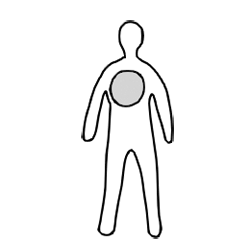
In 1979 the psychologist J.J. Gibson wrote a famous book with a different view—and it can change the way we see the world.
Let’s first look at a traditional viewpoint, which Gibson rejected:
1. Indirect perception
The inner picture
It is tempting to think that we see the world like a camera: A picture is projected on the back of our eyes. And this is of course just a cheap flat copy of the rich outer world.

Our brain then has to analyse this inner picture and guess what the world “outside” is actually like.

So our mind only receives a poor static picture from the eyes and then thinks about what is going on in the world.

Or to put it in technical terms: We receive some stimulus from the outside world, and then our brain responds and tries to find out what it means.
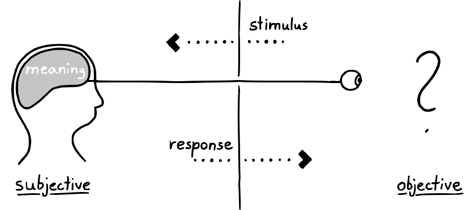
This stimulus-response model separates our inner subjective world from an outer objective world. We can never know for sure what is going on objectively. There is no meaning in the world, it is only in our head.
This traditional take on perception—which goes all the way back to René Descartes—claims that we can not see the world directly.
Gibson thought that this was all wrong.
2. Direct ecological perception
The visual system
First of all, he said, we don’t just sit still like a camera, passively waiting for things to happen. Instead, we move about and actively look around.
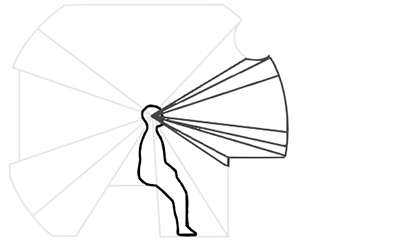
We also don’t see exclusively with our eyes. Did you ever wonder why a recorded video often looks so shaky compared to our own experience? This is because we combine the input from our whole body to receive a stable perception of the world.
„One sees the environment not with the eyes but with the eyes-in-the-head-on-the-body-resting-on-the-ground.“
J.J. Gibson
Even though their role is important, our eyes and our brain are part of a much bigger system that also takes our movement into account. Gibson calls this eyes-in-the-head-on-the-body-resting-on-the-ground our „visual system“.
And this visual system does not produce flat static images over which our minds can muse like an art critic in a gallery. In fact, Gibson criticised the psychologists of his time because they used pictures in their experiments instead of real spatial environments, in which one can move around. This tradition of picture analysis has completely distorted our understanding of how we see the world.
To replace the idea of a static „inner picture“, Gibson proposed dynamic concepts like optic flow patterns, which our visual system detects to distinguish different sorts of movement in our environment.

Because our minds are not deciphering crude images from an external world. Instead our perception happens in the world. It is firmly linked to our movement, to our actions.
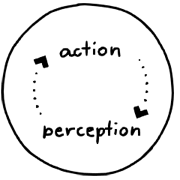
Why? Because we are animals that evolved in this world. And in order to survive we must act.
Affordance
We move around—and look around—to pick up information about what this world has to offer—and what is threatening us. Gibson rejected the idea that we live in a meaningless space with geometric concepts like bodies and planes.

We are not alien souls confronted with a meaningless geometric world. Instead, Gibson suggested, we are animals in an environment. And we are constantly looking around to pick up the opportunities that this environment affords us.

For example, some things might afford us to hold or throw them, to sit on them, or climb them. We don’t do calculations to estimate what a cliff is when we approach one. We immediately see a “falling-off place”.
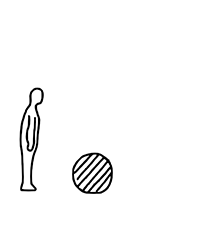
Gibson termed the opportunities of an environment „affordances“. And these affordances constitute what our environment means to us. When we look around we are constantly surrounded by affordances and thus: meaning.
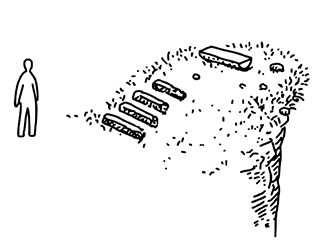
We live in a meaningful world.
This is why Gibson urges us to dispense with the outdated stimulus-response model which suggests that we are foreign minds in a meaningless world. Instead we may understand that the meaning of the world is not something the mind makes up. It is the consequence of the relation between an animal and its environment. We don’t make this meaning. We discover it, we pick it up.
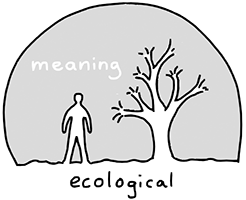
This also entails that different animals can pick up different meanings. Also, different environments offer different meanings.
Why is this useful?
We shape our own environment and what it means. And in return, our man-made environment shapes our perception and our actions. Unsurprisingly Gibson’s ideas have attracted countless designers and architects.
When we create new interactive devices and communication formats, we must design a meaningful environment which people can navigate intuitively. Don Norman established the term „affordance“ among designers. He propagated the necessity to design things that clearly indicate their meaning, which is: what to do with them.

We are used to communication through two dimensional media like sheets of paper or screens. But when we design communication in Virtual Reality we become painfully aware that this „flat“ communication design does not apply to spatial experiences. VR is not only experienced with the eyes but with our whole visual system. Gibson was right: We must take into account that we see with eyes-in-the-head-on-the-body-resting-on-the-ground.

Modern architecture has blessed us with functional machines to live in, and yet we need to ask what our urban environments mean to us. What do they afford us? What meaning does a plain facade, a slick skyscraper, or a bold sculptural statement by a star architect offer us urban animals?
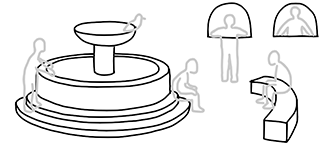
And what is true for those professional designers might even be more important for ourselves in our everyday lives. It is up to us to create meaningful environments.
Living in a meaningful world
Apart from these practical considerations there is another deeper truth to be found in J.J. Gibson’s „Ecological Approach to Visual Perception“: We are not strangers in this world. We are part of it. And this means something.
If you want to dig deeper
Before you go
If you enjoyed this article, then subscribe to my mailing list to receive more animated stories!



7 comments On J.J. Gibson—The meaning of the world
Don Norman introduced «affordances» to the design world. He stated that affordances are whatever you can do with an object or an interface (e.g. lick it) – it doesn’t need to make sense.. Therefore Don Norman also introduced the notation «Signifier» to describe the affordance that should be focussed on by the user. Designers need to be aware of affordances but actually work with signifiers.
Yes, Nicolas. Well put!
Wonderful! Your way of explaining is incredinly ‘simple’. Stae of the art.
This is brilliant dive
Beautiful presentation and meaningful explanation. Great Article. Thanks.
This is brilliant!
Thank you! This is very interesting for me as I am currently exploring in my P.a.R. Ph.D., Screendance artists’ engagement with their creative process and their fusion with their work and viewer responses to this phenomena.